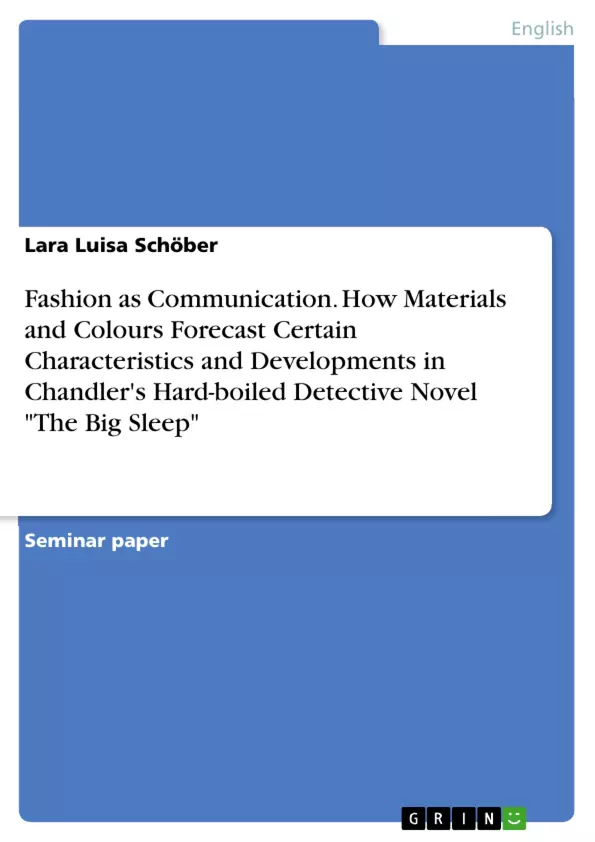After a short introduction into the fashion and dress code of the 1930s, I will expand on the meaning of clothes. Furthermore, I will describe and analyse the fashioning and furnishing of four important characters to prove my thesis. In the fourth chapter I will contextualize the genre of hard-boiled detective fiction, going into its characteristics, history, and origin. The fifth chapter contains a conclusion, which sums up all the facts in reference to hard-boiled fiction in general.
Inhaltsverzeichnis (Table of Contents)
- Introduction
- Dress Code in the 1930s
- Psychology of Fashion
- Dress and Identity
- Nonverbal Communication
- Genre Contextualization of Hard-Boiled Detective Fiction
- Clothing and its Significance in The Big Sleep
- Philip Marlowe
- Arthur Gwynn Geiger
- Eddie Mars
- Carmen Sternwood
- Conclusion
Zielsetzung und Themenschwerpunkte (Objectives and Key Themes)
This paper analyzes the significance of clothing and furnishing in Raymond Chandler’s hard-boiled detective novel The Big Sleep (1939). It aims to demonstrate how detailed descriptions of these elements serve as a non-verbal tool, providing hints about the characters’ moods, identities, and evaluations of the situations. The paper argues that these descriptions foreshadow Geiger’s hidden agenda, Marlowe’s honesty, Eddie Mars’s villainy, and Carmen’s insanity.
- The role of clothing as non-verbal communication in literature
- Fashion and furnishing as indicators of character traits in The Big Sleep
- The psychology of dress and its relation to identity
- The historical context of hard-boiled detective fiction and its relationship to social change
- The use of symbolism in The Big Sleep to create suspense and foreshadowing
Zusammenfassung der Kapitel (Chapter Summaries)
The introduction provides a brief overview of The Big Sleep and its main characters, highlighting the importance of clothing and fashion as a means of communication within the narrative. Chapter 2 explores the fashion trends of the 1930s, highlighting the influence of the Great Depression on women's and men's dress. Chapter 3 delves into the psychological aspects of fashion, exploring how clothing can be seen as a form of non-verbal communication that reflects individual and social identities. Chapter 4 contextualizes the genre of hard-boiled detective fiction, tracing its origins and development.
Schlüsselwörter (Keywords)
The main keywords and focus topics of the text are hard-boiled detective fiction, Raymond Chandler, The Big Sleep, clothing, fashion, non-verbal communication, identity, psychology of dress, symbolism, foreshadowing, Great Depression, social change, and genre contextualization.
- Quote paper
- Lara Luisa Schöber (Author), 2016, Fashion as Communication. How Materials and Colours Forecast Certain Characteristics and Developments in Chandler's Hard-boiled Detective Novel "The Big Sleep", Munich, GRIN Verlag, https://www.grin.com/document/438822



